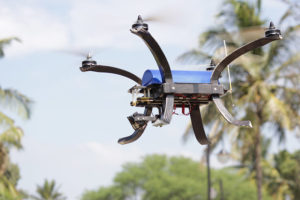Ajay Sukumaran Posted online: Monday, Jul 05, 2010 at 0000 hrs
In a room in central Bangalore, a group of researchers with big plans is gathered for some small talk, or micro talk to be more accurate. Some would call it sci-fi even. With the Indian government last month sanctioning a Rs 90 crore programme to build micro-air vehicles (MICAVs) or flying objects as small as a hand-span, these researchers are setting out to develop new technologies to make the tiny drones see, hear and even smell. The aim is to produce vehicles and sensors for missions ranging from monitoring an industrial gas leak to aerial surveying of floods, reconnaissance or even traffic control in cities.
In 3-4 years, Indian scientists hope to fly a swarm of micro-air vehicles which would be able to communicate with each other through a payload of cameras and sensors to send back images and data to a controller on the ground. The National Programme on micro-air vehicles will be supervised by the Aeronautics Research and Development Board and the development work carried out through the National Aerospace Laboratories (NAL), Indian Institute of Science (IISc), some Indian Institutes of Technology, advanced research labs such as the National Centre for
Biological Sciences, a few tech start-ups and universities.
“We are flying into a totally different realm of aeronautics,” says AR Upadhya, director, NAL. “It is a big programme for us, and in the coming years we would be looking at micro-air vehicles in a big way.” NAL recently concluded a three-year project with DRDO to demonstrate vehicles with wingspans of 300 millimetres to 150 mm with a 200 gm payload. It sees considerable interest from the National Disaster Management Authority and some police departments. “Let us say, a chemical leak or a nuclear leak. You don’t want to send people. You send these in, they will sense the intensity of the leak,” he says.
“From the sensing perspective, it is extremely challenging. Because they are small, we expect them to carry a few grams and do complex things,” says Chandrashekhar Nair, who runs Bigtec Labs, a start-up being incubated at IISc and which is participating in the programme to build micro sensors for a variety of applications such as sensing explosives or toxic acids.
“We want to exploit the strength available in Indian academic institutes,” says Prahlada, chief controller, research and development (services interaction) at DRDO, who is the chairman of the executive board of the MICAV programme. “We are likely to generate half a dozen types of birds.”
The ‘birds’ they are looking at would be 300-150 mm planes and helicopters and those with flapping wings like real birds as the research into MICAVs would also draw on biomimetics—the application of biological systems such as in insects and birds in engineering.
“All the projects are tightly monitored, all of them have deliverables. It’s very product oriented,” says N Chandrashekar, who along with son Uttam, runs DC Enterprises in Bangalore. The duo, who make and export electric motors weighing 3 gm or less to a niche market of universities and research institutions in the US and Europe, plan to build a couple of MICAVs under the programme.
Scientists in India began talking about researching micro-air vehicles in 1998 and a decade’s work of developing the basic technology and proving feasibility has led to the national programme, says Lt.Gen. (retd) VJ Sundaram, former chairman of the programme management board of India’s Integrated Guided Missile Development Programme. As advisor (micro and nano systems) to National Design and Research Forum, the R&D platform of the Institution of Engineers, he has been a key figure behind the programme and has set the ultimate objective of replicating a bumble-bee.
Sundaram’s room at NDRF in Bangalore is the think-tank of a consortium of private labs and universities that will work on technologies not covered by project centres such as NAL and IISc. “We take different approaches to develop MICAVs. Each person will be coming up with a system and sub systems,” says Krishna Venkatesh, whose Bangalore-based start-up, Drone Aerospace Systems, is working on auto-pilot systems, ground station software and low weight radio modems.
Globally, research into MICAVs has had a head start compared to India. A 14 inch diameter vehicle made by Honeywell Aerospace has been deployed with the US Army in Iraq since 2007 for surveillance and to search for improvised explosive devices. But scientists here say that the country is catching up fast.
“This programme has come at the right time. I think we have the opportunity to possibly even lead in that area,” says Bigtec’s Nair who reckons that similar national programmes on smart materials and structures have helped bridge the gap by evolving the technologies which are now being used for MICAVs. “It has been a process of constantly maturing,” he says.
“The idea is to develop them because all these are in the realm of dual use technology and you know that anything dual-use can be stopped at anytime,”says NAL’s Upadhya. “So while one may say these are all available abroad and what is new, it is new for us. We need to develop on our own.”
NAL already has a roadmap towards newer frontiers. In the 12th five year plan, it gears up to propose a programme to build MICAVs as small as 75 mm.

